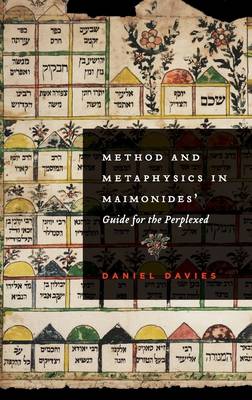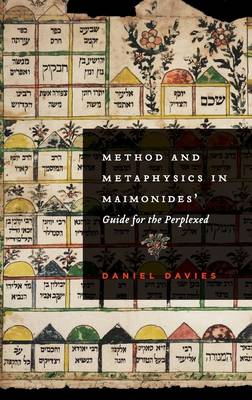
Bedankt voor het vertrouwen het afgelopen jaar! Om jou te bedanken bieden we GRATIS verzending (in België) aan op alles gedurende de hele maand januari.
- Afhalen na 1 uur in een winkel met voorraad
- Gratis thuislevering in België
- Ruim aanbod met 7 miljoen producten
Bedankt voor het vertrouwen het afgelopen jaar! Om jou te bedanken bieden we GRATIS verzending (in België) aan op alles gedurende de hele maand januari.
- Afhalen na 1 uur in een winkel met voorraad
- Gratis thuislevering in België
- Ruim aanbod met 7 miljoen producten
Zoeken
Omschrijving
Maimonides' Guide for the Perplexed is one of the most discussed books in Jewish history. More than 800 years after the author's death it remains hotly debated, with readers seeking secret philosophical messages behind its explicit teachings, a quest fueled partly by Maimonides' own statement that certain parts of the Guide are based upon ideas that conflict with other parts. Through close readings of Maimonides' work, Daniel Davies addresses the major debates surrounding its secret doctrine. He argues that perceived contradictions in Maimonides' accounts of creation and divine attributes can be squared by paying attention to the various ways in which he presented his arguments. Davies shows how a coherent theological view can emerge from the many layers of the Guide. However, Maimonides' clear declaration that certain matters must be hidden from the masses cannot be ignored, and the kind of inconsistency that is peculiar to the Guide requires another explanation. It is found in the purpose Maimonides assigns to the Guide: scriptural exegesis. Davies offers a detailed exposition of Maimonides' interpretation, the deepest "secret of the Torah" which, in Maimonides' works, shares its name with metaphysics. By connecting the secret with currents in the Islamic world, the chapters show how Maimonides devised a new method of presentation in order to imitate scripture's multi-layered manner of communication. He updated what he took to be the correct interpretation of scripture by writing it in a work appropriate for his own time and to do so he had to keep the Torah's most hidden secrets.
Specificaties
Betrokkenen
- Auteur(s):
- Uitgeverij:
Inhoud
- Aantal bladzijden:
- 224
- Taal:
- Engels
- Reeks:
Eigenschappen
- Productcode (EAN):
- 9780199768738
- Verschijningsdatum:
- 15/09/2011
- Uitvoering:
- Hardcover
- Formaat:
- Genaaid
- Afmetingen:
- 160 mm x 236 mm
- Gewicht:
- 453 g

Alleen bij Standaard Boekhandel
+ 296 punten op je klantenkaart van Standaard Boekhandel
Beoordelingen
We publiceren alleen reviews die voldoen aan de voorwaarden voor reviews. Bekijk onze voorwaarden voor reviews.












